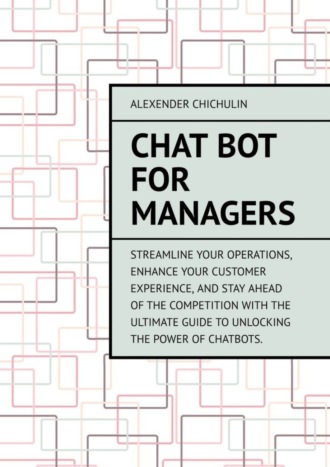
Полная версия
Chat bot for managers

Chat bot for managers
Alexender Chichulin
© Alexender Chichulin, 2023
ISBN 978-5-0060-0518-1
Created with Ridero smart publishing system
1. Introduction
– Definition of chat bots and their benefits for managers
Chat bots are computer programs designed to simulate conversation with human users, usually through messaging or voice interfaces. They have become increasingly popular in recent years, particularly in customer service and sales, due to their ability to provide quick and efficient responses to queries and provide personalized assistance. However, chat bots can also be incredibly useful for managers, providing a range of benefits such as:
– Streamlining communication and improving response times
– Automating repetitive tasks and freeing up time for more strategic work
– Providing real-time data and analytics to inform decision-making
– Enhancing customer experience and satisfaction
– Reducing costs associated with hiring and training additional staff
In this section, we will explore these benefits in more detail and discuss how chat bots can help managers in various industries and functions.
– Overview of the guide and what readers can expect
This guide is designed to provide a comprehensive overview of chat bots for managers. It will cover everything from the basics of chat bots and their benefits for managers, to the process of planning, building, deploying, and maintaining a chat bot. The guide is written in a language that is easily understandable by all readers, regardless of their technical background.
The guide is divided into several sections, starting with an introduction to chat bots and their benefits for managers. We will then delve into the different types of chat bots, how they work, and their advantages and disadvantages. After that, we will explore the planning and building process, including how to identify your goals and objectives, choose the right platform and tools, design your chat bot conversation flow, and integrate it with other systems.
We will then move on to the training and deployment of your chat bot, covering topics such as testing, data collection and feedback, refining and improving your chat bot, and strategies for promoting it. We will also discuss how to measure success and ROI.
The guide also includes a section on maintaining and improving your chat bot, which covers monitoring and analyzing chat bot performance, making necessary updates and improvements, and scaling up your chat bot. We will also provide real-life case studies of successful chat bot implementations, as well as an exploration of emerging trends and potential future applications for chat bots.
By the end of this guide, readers should have a comprehensive understanding of chat bots and how they can be used to benefit managers. Whether you are new to chat bots or an experienced user, this guide will provide valuable insights and practical advice to help you make the most of this technology.
2. Understanding Chat Bots
– What are chat bots?
Chat bots are computer programs that are designed to simulate human conversation through messaging or voice interfaces. They are often used to automate customer service, sales, and support interactions, but they can also be used for a wide range of other purposes.
Chat bots use natural language processing (NLP) and artificial intelligence (AI) to understand and interpret user input, allowing them to respond with pre-programmed or customized answers. Some chat bots are designed to handle simple, repetitive tasks such as answering FAQs, while others are more advanced and can handle more complex interactions, such as booking appointments or conducting surveys.
There are various types of chat bots, including rule-based bots, which operate on a set of predefined rules, and AI-based bots, which use machine learning algorithms to learn and adapt to user interactions over time. Chat bots can be integrated with various messaging platforms, such as Vk, WhatsApp, and Slack, or they can be deployed as standalone applications.
Overall, chat bots are a powerful tool for automating tasks, improving customer service, and enhancing efficiency in a wide range of industries and functions.
– Types of chat bots
1. Rule-based chat bots: These bots operate on a set of predefined rules and are programmed to respond to specific keywords or phrases. They are often used for simple, straightforward tasks, such as answering frequently asked questions or providing basic customer service.
2. AI-based chat bots: These bots use natural language processing (NLP) and machine learning algorithms to understand and interpret user input, allowing them to provide more personalized and nuanced responses. AI-based chat bots can learn from past interactions and improve over time.
3. Task-oriented chat bots: These bots are designed to handle specific tasks or processes, such as booking a reservation, placing an order, or scheduling a meeting. They are often used in industries such as hospitality, e-commerce, and healthcare.
4. Virtual assistant chat bots: These bots are similar to task-oriented bots but are designed to provide more comprehensive support, such as managing email, setting reminders, or conducting research. They are often used for personal or business productivity.
5. Social chat bots: These bots are designed to interact with users on social media platforms, such as Vk, Vk, or Telegram. They can be used for various purposes, such as engaging with customers or conducting marketing campaigns.
6. Hybrid chat bots: These bots combine elements of both rule-based and AI-based chat bots, allowing them to handle both simple and complex interactions. Hybrid chat bots are often used in customer service or support contexts.
There are also industry-specific chat bots designed for sectors such as finance, healthcare, education, and more. Ultimately, the type of chat bot you choose will depend on your specific needs and goals.
– How chat bots work
1. User input: Chat bots begin by receiving input from users through a messaging or voice interface. This input can take various forms, such as text, voice, or images.
2. Natural Language Processing (NLP): Once the input is received, the chat bot uses natural language processing (NLP) technology to analyze and interpret the user’s message. This involves breaking down the user’s message into its constituent parts, such as keywords, entities, and intents.
3. Decision making: Based on the information gathered from the user’s message, the chat bot then decides how to respond. This can involve using pre-programmed rules or machine learning algorithms to determine the appropriate response.
4. Output generation: Once the response has been decided, the chat bot generates an output message, which is sent back to the user through the messaging or voice interface. The output message can take various forms, such as text, images, or audio.
5. Learning and improvement: Over time, chat bots can learn and improve through user feedback and interaction data. This can involve using machine learning algorithms to identify patterns and improve the accuracy and relevance of responses.
The specific details of how chat bots work can vary depending on the type of bot and the underlying technology used. However, the basic process of receiving input, processing it, and generating a response is common to most chat bots.
– Advantages and disadvantages of chat bots
Advantages:
1. 24/7 availability: Chat bots can be available to users around the clock, providing immediate support and assistance.
2. Cost-effective: Chat bots can reduce the need for human staff, leading to cost savings for businesses.
3. Improved efficiency: Chat bots can handle simple, repetitive tasks quickly and accurately, freeing up human staff to focus on more complex tasks.
4. Scalability: Chat bots can handle a large volume of interactions simultaneously, making them ideal for businesses with high customer traffic.
5. Personalization: AI-based chat bots can provide personalized responses based on user data, improving the user experience.
6. Increased engagement: Chat bots can increase engagement with users, leading to higher satisfaction and retention rates.
Disadvantages:
1. Limited ability to handle complex tasks: Chat bots may struggle to handle complex tasks that require human judgment or decision-making.
2. Language limitations: Chat bots may struggle to understand colloquial language, regional accents, or slang.
3. Initial development costs: Developing a chat bot can be expensive, particularly if it requires custom AI or NLP technology.
4. Potential for errors: Chat bots may make errors or provide inaccurate responses, particularly if they are rule-based and don’t have the ability to learn from past interactions.
5. Lack of emotional intelligence: Chat bots may struggle to understand and respond appropriately to emotional or sensitive topics.
6. User mistrust: Some users may be skeptical of chat bots and prefer to interact with human staff.
Overall, chat bots can provide significant benefits in terms of cost savings, efficiency, and improved user experience. However, they are not suitable for all tasks and may require careful planning and development to ensure they provide the intended benefits.
3. Benefits of Chat Bots for Managers
– Time-saving
1. Quick response times: Chat bots can respond to user inquiries and requests in a matter of seconds, reducing wait times and improving overall response times.
2. Automation of routine tasks: Chat bots can handle routine tasks, such as answering frequently asked questions or processing simple transactions, without human intervention, freeing up staff time for more complex tasks.
3. Multitasking: Chat bots can handle multiple interactions simultaneously, allowing them to process a high volume of requests and inquiries in a short amount of time.
4. Availability: Chat bots are available 24/7, reducing the need for human staff to work outside of regular business hours.
5. Speed of implementation: Chat bots can be developed and implemented relatively quickly, reducing the time and effort required to implement new services or processes.
6. Reduction of errors: Chat bots can reduce the occurrence of errors in routine tasks, improving accuracy and reducing the need for manual review.
Overall, chat bots can save time by streamlining routine tasks, automating processes, and reducing response times. This can lead to increased productivity, improved customer service, and cost savings for businesses.
– Improved productivity
1. Handling routine tasks: Chat bots can handle routine tasks, such as answering frequently asked questions or processing simple transactions, without human intervention, freeing up staff time for more complex tasks.
2. Multitasking: Chat bots can handle multiple interactions simultaneously, allowing them to process a high volume of requests and inquiries in a short amount of time.
3. Faster response times: Chat bots can respond to user inquiries and requests in a matter of seconds, reducing wait times and improving overall response times.
4. Reduced workload: By handling routine tasks and inquiries, chat bots can reduce the workload on human staff, allowing them to focus on more complex tasks.
5. Increased efficiency: Chat bots can improve efficiency by automating processes and reducing the need for manual review and intervention.
Конец ознакомительного фрагмента.
Текст предоставлен ООО «ЛитРес».
Прочитайте эту книгу целиком, купив полную легальную версию на ЛитРес.
Безопасно оплатить книгу можно банковской картой Visa, MasterCard, Maestro, со счета мобильного телефона, с платежного терминала, в салоне МТС или Связной, через PayPal, WebMoney, Яндекс.Деньги, QIWI Кошелек, бонусными картами или другим удобным Вам способом.











